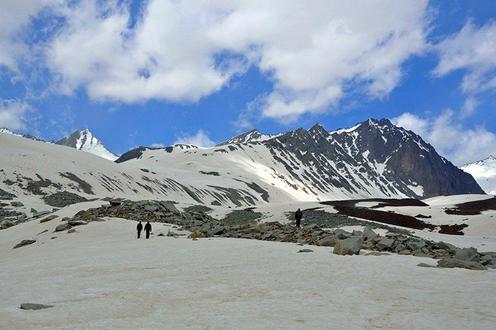Tajik scientists have announced that the Zeravshan glacier, one of the largest glaciers in Central Asia, has receded 1700 metres over the last 40 years, writes Radio Liberty’s Tajik website Ozodi (in Russian).
The scientists compared surveys of the glacier from 1979, 1991, 2009 and 2019. Photograph images clearly show scientists in 1979 standing high up on a mass of ice, at a spot which today stands totally bare. The glacier has shrunk by an average of 40 metres each year.
According to Alexander Pirov, head of the glaciology department of the Agency for Hydrometeorology of Tajikistan, the glacier’s retreat is a natural process, but the rate of melting over recent years constitutes a major cause for concern, as the huge 25km-long glacier has shrunk by 7% over the course of a few decades.
One of the Zeravshan glacier’s tributaries, Rama glacier, is itself losing 85 metres a year and has shrunk by 2.6km over the last 20 years. With an increase in temperatures, Pirov does not rule out the possibility of one of the largest branches of the Zeravshan glacier – Skachkov glacier – detaching itself from the main body.
Pirov suggests that climate change and the loss of snow cover lie behind the increased melting. Scientists say that as a result of climate change, snow-melt in the mountains of Tajikistan now starts in the middle of March, rather than in April as in previous years.
The findings were published on the eve of the international climate change conference currently underway in Madrid, which will be attended by a Tajik delegation.
The Zeravshan glacier is a long, branching glacier in Tajikistan, the largest in the Hissaro-Alay mountain range. It is composed of the main trunk and 20 large tributary glaciers. It gives birth to the river Matcha, a major tributary of the Zeravshan river, which provides water to around six million inhabitants of Tajikistan and Uzbekistan. According to scientists, the retreat of the glaciers and the reduction in ice cover will have a negative impact not only on the volume of water in the Zeravshan river, but also on all other major rivers in the region.










